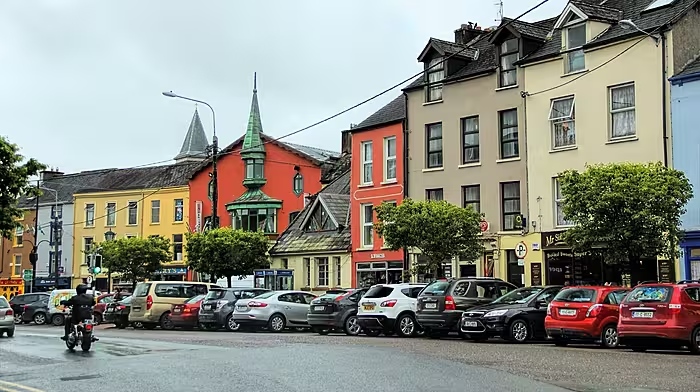The young woman in the photo from the Lawrence Photograph Collection in the National Library of Ireland died 100 years ago on February 19th, 1921, a casualty in the War of Independence.
Her name is Mary O’Connor and her grandson, Brendan Lyons, writes. ‘The photo shows her in front of the Tunnel Cottage, a teashop that she operated with her husband, Patrick. The border between Cork and Kerry runs through the Long Tunnel on the Glengarriff to Kenmare road and Mary and Patrick’s tea shop was just on the Cork side of the border.
Mary and Patrick were a young local couple, she from Derryconnery and he from Innisfoyle, Bonane. They were 22 and 25 respectively when they married in 1905. They acquired the small cottage from a relative and built a two-storey house beside it. By all accounts the teashop was successful. The Tunnel, hand-hewn in the 1830s, was and still is, a significant landmark. Postcards published by Valentines, Judges and others testify to its popularity as a stopping-off point for charabancs and for individual tourists. A photo of the inside of the Tunnel itself was included in a book presented in 1903 to King Edward VI in commemoration of his visit to Munster. As the Tunnel Cottage was the only teashop at the site, Mary and Patrick had a captive market.
By 1910-1915 Mary and Patrick had done well enough to improve the house and cottage. They bridged the gap between the two houses by adding an upper floor to the cottage and linked it across the gap to the main house. They bricked up the space below the link and plastered the two buildings as one. The new space was used for storage and access to it was by way of a ladder from a trapdoor at the first level in what was the children’s bedroom. The decision to leave a gap at ground level was probably taken on grounds of cost - inserting lintels into two dry stone walls would not have been easy or cheap. Whatever the reason for the now enclosed and concealed space, it was to prove significant later.
The period from mid-1920 to early 1921 was a fraught time in West Cork. In the summer of 1920, Royal Irish Constabulary (RIC) constables had been killed in Bantry and Glengarriff; the Tooreen Ambush and its aftermath in Bandon took place in October; and the Bloody Sunday Massacre in Dublin and the Kilmichael Ambush both took place in November. Martial law was declared in Cork, Kerry, Limerick, and Tipperary in December and the centre of Cork city was burned down by the Black and Tans. There were many incidents, and curfews were put in place.
In Glengarriff, the British were concerned that suspected IRA Volunteers could disappear between Glengarriff and Kenmare, particularly at night. They had no idea where the Volunteers might be hiding, and the remoteness and isolation of the countryside where the road crossed the Caha Mountains seemed to provide excellent cover.
The Tunnel Cottage was one of the very few houses on the road once Glengarriff was left behind, but it doesn’t appear that the teashop was suspected as a hideout. It looked innocent enough. It was a successful business in a substantial building, run by a young family, which included six young children. Mary and Patrick were an affable pair and provided refreshments to all traveller’s, including military personnel, passing by. However, unbeknownst to these customers, their hosts used the space between the two houses to hide active service Volunteers. One of Mary’s daughters later recalled to her own children how her bed and the rug beneath it would be moved, and men would go down into the space below. Then her bed would be moved back, and she would go back to sleep.
In February 1921 Mary was in the late stages of pregnancy. On the night of February 18th, she began to haemorrhage. Despite the curfew, Patrick knew that he had to get a doctor urgently and he rode to Glengarriff. Unfortunately, he ran into a patrol, which instead of helping him get the doctor, arrested him for breaching the curfew. He was then detained overnight and questioned about his movements and what he knew about the ability of the Volunteers to disappear.
The next morning an English officer came to the station who happened to have stopped in at the Tunnel Cottage teashop a little time before. He had seen that Mary was heavily pregnant and was able to confirm Patrick’s reason for breaking the curfew. He ordered Patrick’s release and provided an escort for Patrick and the doctor to return to the Tunnel. Sadly, they were too late. By the time Patrick arrived home Mary had died from ‘shock and haemorrhage’ as the death certificate recorded.
Mary died nine days before their 16th wedding anniversary, widowing a 40 year old Patrick and orphaning her six children whose ages ranged from fourteen to three. Within eight years, Patrick was dead, and the children were scattered in Ireland, Great Britain and America.
Mary O’Conor is Des Bishop’s great grandmother and Des has released a podcast called ‘My Great Grandmother’s death during the War of Independence -100 years ago this week.’







